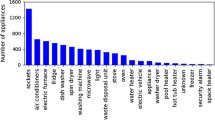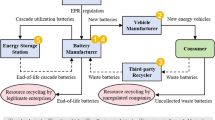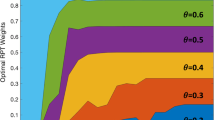Abstract
Under the ruling of FERC Order 2222, prosumers who own distributed energy resources are expected to play an essential role that can significantly affect the market outcomes. This paper assesses the market power potential of a risk-averse prosumer by designating it as a Stackelberg leader in the market. We formulate the problem as a mathematical program with equilibrium constraints with a distributionally robust chance-constrained framework to account for the renewable generation uncertainty. The numerical results demonstrate that the prosumer’s strategy depends on the magnitude of renewable generation uncertainty and the degree of risk aversion, which jointly affect the perceived quantity of its renewable resources. The risk-averse Stackelberg case always yields a higher payoff for the prosumer compared to the Cournot and perfect competition cases. Moreover, it is more potent for the prosumer to exercise buyer’s market power rather than seller’s market power. The situation worsens when the prosumer is less risk averse. This highlights the importance of understanding the role of the prosumer acting either as a consumer or as a producer and the risk faced by the prosumer when evaluating its interaction with the wholesale market.


Similar content being viewed by others
Notes
A recent thread of literature has also focused on the role of aggregators as middle-men in the power sector that operate DERs on behalf of owners and their interactions with the wholesale power market [3, 4]. The heterogeneity in terms of geographical placement and type of resources owned by the prosumers grants them a competitive advantage, as the information is likely to be private, only known by prosumers. This also calls for a careful examination of DERs market power potential in the market [6], and other studies have shown that even low levels of wind penetration could enable strategic manipulation, leading to efficiency loss [7, 8].
In fact, a recent report concludes that by 2050, prosumers can produce twice as much power as nuclear production now in Europe (https://www.greenbird.com/news/utility-death-spiral).
For instance, prosumers are allowed to participate in a day-ahead market but are subject to a fixed retail or contracted rate in real time, similar to the situation faced by several EU countries, e.g., Italy, Netherlands, and Belgium [31].
Two concerns, privacy and truth-telling, are worth more discussion. We believe that neither should be a significant concern in the current context. Considering that DERs owners enter a contract with a prosumer, e.g., OhmConnect in [32], the contract will then specify the types of necessary private information from the owner and how the information will be handled. Moreover, given that the prosumer is tasked to maximize the joint profit of participants, non-truth-telling by end-prosumers would undermine its ability to maximize the joint profit on their behalf.
We assume a diesel generator that exhibits an increasing marginal cost. Moreover, the backup on-site generation can represent or be generalized to various options. It could also be a battery system characterized by an increasing marginal cost as storing energy over time may incur additional costs due to round-trip (in)efficiency.
\(B^{l\prime }_i\) is entirely separated and different from \(B^{\prime }_i\) that represents willingness-to-pay of consumers in the wholesale market. One can subject them to a sensitivity analysis to understand their impacts on the outcomes. However, since the prosumer’s strategy is mainly impacted by how much renewable generation it faces, and its net position as a net seller or a net buyer with respect to the wholesale market, our numerical example in Sect. 3 examines these two possibilities explicitly by changing the level of the mean renewable output.
Had the prosumers been modeled to allow to sell surplus power from its local node i to other locations, it is expected to produce the same market outcomes [15].
Of course, the voltage variation at the distributional level could be a concern. Given that (1) our main interest lies at the wholesale level as well as (2) the fact that prosumers can aggregate over various DERs over space, each with a small capacity, which will have a limited impact on voltages in the medium voltage circuits, we therefore abstract from representing the distribution network. An example is OhmConnect, which recently announced a plan to link homes dispersed in California to form a 550-MW virtual power plant (VPP) of DERs [32].
The interaction of the prosumer with the day-ahead wholesale energy market is modeled through shifting of demand curves of conventional consumers. An alternative way of modeling this situation is to horizontally aggregate consumers’ and prosumers’ demand curves. However, this aggregation might lead to kinked demand curves, which poses numerical difficulties, see [33] for example.
In fact, (6) is binding in equilibrium. Thus, for a given \(P^c_i\), the second line of (5a) is equal to \(\sum _i P^c_i \sigma _i \sqrt{\frac{1-R_i}{R_i}}\), which is a constant. The term \(\sigma _i \sqrt{\frac{1-R_i}{R_i}}\) can be regarded as expected imbalance settlement quantity in real time. With fixed \(\sigma _i\) and \(R_i\), expected real-time balancing is the same regardless of the prosumer’s strategies (see also Tables 1, 2 and 3). However, note that a change in the renewable output uncertainty \(\sigma _i\) or prosumer’s risk preference \(R_i\) indeed affects the outcomes through (6).
All the results presented in this section exclude revenue/cost in real time, which is a constant across different market structures.
As alluded to in Footnote 10, the expected real-time imbalance settlement, \(\sum _i P^c_i \sigma _i \sqrt{\frac{1-R_i}{R_i}}\), is the same constant across different market structures with fixed \(P^c_i\), \(\sigma _i\) and \(R_i\). We exclude it when calculating prosumer surplus in the day-ahead market. An interesting observation pointed out by one of the referees is worth noting. When the difference between day-ahead and real-time imbalance prices is small, the prosumer may become less risk averse (i.e., larger \(R_i\)), anticipating that the costs incurred in the real-time imbalance settlement would not be significant even in a worse situation. This may lead the prosumer to purchase less from the day-ahead market. However, modeling prosumer’s endogenous risk preference is beyond the scope of the paper and we leave it to our future work.
This only includes the power purchases by the conventional consumers, i.e., \(\frac{\sum _ip_id_i}{\sum _id_i}\); that is, the power purchases by the prosumer when it is in a short position are not included. However, it considers the sales by the prosumer when it is in a long position.
The seemingly indiscernible difference in the social surplus when a prosumer is in a short position is partially attributed to the modest size of the prosumer. Had the prosumer grown to be larger, the difference would enlarge. We note that our interest in this paper lies in the order of social surplus or other indicators among cases rather than the absolute difference. However, when the prosumer is in a long position, the gap in the wholesale social surplus may remain small even if the prosumer becomes larger. This would highlight again the greater potential of market power by the prosumer when it is in a short position.
The impacts of \(R_1\) and \(\sigma _1\) when the prosumer is in a long position, selling energy to the grid, can be analyzed in a similar way. In particular, a larger \(K_1^{perceived}\) as in Table 4 encourages the prosumer to sell more energy, which is expected to lower sales-weighted power prices and makes consumers better off. On the other hand, a smaller \(K_1^{perceived}\) as in Table 5 induces the prosumer to sell less energy, resulting in lower consumer surplus with higher sales-weighted power prices.
References
Federal Energy Regulatory Commission: FERC Opens Wholesale Markets to Distributed Resources: Landmark Action Breaks Down Barriers to Emerging Technologies, Boosts Competition. https://www.ferc.gov/news-events/news/ferc-opens-wholesale-markets-distributed-resources-landmark-action-breaks-down (2020)
Li, R., Wu, Q., Oren, S.S.: Distribution locational marginal pricing for optimal electric vehicle charging management. IEEE Trans. Power Syst. 29(1), 203–211 (2013)
Papavasiliou, A., Oren, S.S.: Large-scale integration of deferrable demand and renewable energy sources. IEEE Trans. Power Syst. 29(1), 489–499 (2013)
Gkatzikis, L., Koutsopoulos, I., Salonidis, T.: The role of aggregators in smart grid demand response markets. IEEE J. Sel. Areas Commun. 31(7), 1247–1257 (2013)
Kristov, L.: The bottom-up (r) evolution of the electric power system: the pathway to the integrated-decentralized system. IEEE Power Energy Magn. 17(2), 42–49 (2019)
Bose, S., Wu, C., Xu, Y., Wierman, A., Mohsenian-Rad, H.: A unifying market power measure for deregulated transmission-constrained electricity markets. IEEE Trans. Power Syst. 30(5), 2338–2348 (2014)
Alshehri, K., Ndrio, M., Basar, S.B.T.: The impact of aggregating distributed energy resources on electricity market efficiency. In: Annual Conference on Information Sciences and Systems (CISS) (2019)
Yu, Y., Zhang, B., Rajagopal, R.: Do wind power producers have market power and exercise it? In: 2014 IEEE PES General Meeting, pp. 1–5. IEEE (2014)
Baringo, L., Conejo, A.J.: Strategic offering for a wind power producer. IEEE Trans. Power Syst. 28(4), 4645–4654 (2013)
Ding, H., Pinson, P., Hu, Z., Wang, J., Song, Y.: Optimal offering and operating strategy for a large wind-storage system as a price maker. IEEE Trans. Power Syst. 32(6), 4904–4913 (2017)
Han, X., Hug, G.: A distributionally robust bidding strategy for a wind-storage aggregator. Electric Power Syst. Res. 189, 106745 (2020)
Rashidizadeh-Kermani, H., Vahedipour-Dahraie, M., Parente, M., Shafie-Khah, M., Siano, P.: Strategic offering of a price maker wind power producer in distribution-level energy markets in presence of flexible prosumers. IEEE Access 10, 21475–21485 (2022)
Xiao, X., Wang, J., Lin, R., Hill, D.J., Kang, C.: Large-scale aggregation of prosumers toward strategic bidding in joint energy and regulation markets. Appl. Energy 271, 115159 (2020)
Siddiqui, A.S., Siddiqui, S.A.: Ambiguities and nonmonotonicities under prosumer power. TOP, 1–41 (2022)
Ramyar, S., Liu, A., Chen, Y.: A power market model in presence of strategic prosumers. IEEE Trans. Power Syst. 35(2), 898–908 (2020)
Ramyar, S., Chen, Y.: Leader-follower equilibria for power markets in presence of prosumers. In: HICSS (2020)
Day, C.J., Hobbs, B.F., Pang, J.-S.: Oligopolistic competition in power networks: a conjectured supply function approach. IEEE Trans. Power Syst. 17(3), 597–607 (2002)
Hobbs, B.F.: Linear complementarity models of Nash–Cournot competition in bilateral and POOLCO power markets. IEEE Trans. Power Syst. 16(2), 194–202 (2001)
Chen, C., Kishore, S., Wang, Z., Alizadeh, M., Scaglione, A.: How will demand response aggregators affect electricity markets?-a cournot game analysis. In: 2012 5th International Symposium on Communications, Control and Signal Processing, pp. 1–6 (2012). IEEE
Chen, Y., Hobbs, B.F., Leyffer, S., Munson, T.S.: Leader-follower equilibria for electric power and NOx allowances markets. CMS 3(4), 307–330 (2006)
Entriken, R., Wan, S.: Agent-based simulation of an automatic mitigation procedure. In: Proceedings of the 38th Annual Hawaii International Conference on System Sciences, pp. 92–92 (2005). IEEE
Entriken, R., Wan, S.: Pushing capacity payments forward: agent-based simulation of an available capacity market. Technical report, EPRI Technical Report (Available at https://www.epri.com/research/products/1007755 (2003)
Hobbs, B.F., Metzler, C.B., Pang, J.-S.: Strategic gaming analysis for electric power systems: an MPEC approach. IEEE Trans. Power Syst. 15(2), 638–645 (2000)
Hu, X., Ralph, D., Ralph, E.K., Bardsley, P., Ferris, M.C., et al.: Electricity generation with looped transmission networks: Bidding to an ISO. Research Paper 16 (2004)
Pepermans, G.: Ramsey pricing in a congested network with market power in generation: A numerical illustration for Belgium. KU Leuven CES; Leuven Working Papers, pp. 1–38 (2004)
Gabriel, S.A., Leuthold, F.U.: Solving discretely-constrained MPEC problems with applications in electric power markets. Energy Econ. 32(1), 3–14 (2010)
Siddiqui, S., Gabriel, S.A.: An sos1-based approach for solving MPECS with a natural gas market application. Netw. Spat. Econ. 13(2), 205–227 (2013)
Ruhi, N.A., Dvijotham, K., Chen, N., Wierman, A.: Opportunities for price manipulation by aggregators in electricity markets. IEEE Trans. Smart Grid, 1–1 (2017)
Lubin, M., Dvorkin, Y., Backhaus, S.: A robust approach to chance constrained optimal power flow with renewable generation. IEEE Trans. Power Syst. 31(5), 3840–3849 (2016)
Luo, Z.-Q., Pang, J.-S., Ralph, D.: Mathematical Programs with Equilibrium Constraints. Cambridge University Press, Cambridge (1996)
Inês, C., Guilherme, P.L., Esther, M.-G., Swantje, G., Stephen, H., Lars, H.: Regulatory challenges and opportunities for collective renewable energy prosumers in the EU. Energy Policy 138, 111212 (2020)
PV Magazine: World’s Largest Residential Virtual Power Plant Coming from Alphabet-Backed SIP and OhmConnect (2020). www.pv-magazine-usa.com/2020/12/07/worlds-largest-residential-virtual-power-plant-coming-from-alphabet-backed-sip-and-ohmconnect
Hobbs, B.F., Pang, J.-S.: Nash–Cournot equilibria in electric power markets with piecewise linear demand functions and joint constraints. Oper. Res. 55(1), 113–127 (2007)
Calafiore, G.C., El Ghaoui, L.: On distributionally robust chance-constrained linear programs. J. Optim. Theory Appl. 130(1), 1–22 (2006)
Fortuny-Amat, J., McCarl, B.: A representation and economic interpretation of a two-level programming problem. J. Oper. Res. Soc. 32(9), 783–792 (1981)
Schneider, A.: The IEEE reliability test system-1996: A report prepared by the reliability test system task force of the application of probability methods subcommittee. discussion. IEEE Trans. Power Syst. 14(3), 1010–1020 (1999)
Wang, J., Redondo, N.E., Galiana, F.D.: Demand-side reserve offers in joint energy/reserve electricity markets. IEEE Trans. Power Syst. 18(4), 1300–1306 (2003)
Azevedo, I.M.L., Morgan, M.G., Lave, L.: Residential and regional electricity consumption in the US and EU: How much will higher prices reduce Co2 emissions? Electr. J. 24(1), 21–29 (2011)
Gibbons, R.S.: Game Theory for Applied Economists. Princeton University Press, Princeton (1992)
Chen, Y., Hobbs, B.F.: An oligopolistic power market model with tradable NO\(_x\) permits. IEEE Trans. Power Syst. 20(1), 119–129 (2005)
Author information
Authors and Affiliations
Corresponding author
Additional information
Publisher's Note
Springer Nature remains neutral with regard to jurisdictional claims in published maps and institutional affiliations.
Appendices
Appendix A: Wolfe duality of lower-level problem
Since the lower-level problem is a concave program, we can obtain the optimal solution by solving its dual. Particularly, if we have a general concave program \(\textrm{max}_{x} \{f(x):g(x)\le 0\}\), the corresponding Wolfe dual is \(\textrm{min}_{x,\lambda }\{{\mathcal {L}}(x,\lambda ): \nabla _x {\mathcal {L}}(x,\lambda ) = 0, \lambda \ge 0\}\), where \(\nabla _x {\mathcal {L}}(x,\lambda )\) are the gradients of the Lagrangian \({\mathcal {L}}(x,\lambda ) = f(x) - \lambda ^{\top } g(x)\). For a concave (or convex) programming problem, strong duality holds between the primal and Wolfe dual problems. Consequently, the Wolfe dual of the social welfare maximization problem in the lower level is:
Note that non-negativity constraints are imposed on \(\{\beta _{fih},\lambda ^+_k,\lambda ^-_k,\varepsilon _{fih},\xi _i\}\), which are associated with the inequality constraints in the primal problem. Otherwise, variables are unrestricted.
Given the concavity of the social welfare maximization problem and that strong duality holds, the original objective functions and (A.1a) have the same value. Thus:
Using constraints (A.1b)–(A.1d), we further simplify (A.2). In particular, from (A.1b) we have:
From (A.1c), we derive:
Fom (A.1d), we obtain:
Substituting (A.3), (A.4), and (A.5) into (A.2), we can rewrite the bilinear term \(\sum _{i}\eta _i z_{i}\) as follows:
Appendix B: Concavification of objective function in MPEC
We can then substitute (A.6) into the bilinear term \(\sum _{i}\eta _i z_{i}\) in the original objective function of the MPEC. Along with other constraints, the objective function of MPEC, or the Stackelberg leader formulation for the prosumer, is then rewritten as follows:
Appendix C: MIQP reformulation
As the final step, we further remove non-convex terms caused by the complementarity conditions from the lower-level problem by utilizing disjunctive constraints. With binary variables Φ = \(\{{\bar{r}}_{fih}, r^+_k, r^-_k, r_{fih},{\hat{r}}_i\}\) and positive big constants \(\{M_1,M_2,M_3,M_4,M_5\}\), we reformulate the MPEC into an MIQP as follows:
Rights and permissions
Springer Nature or its licensor (e.g. a society or other partner) holds exclusive rights to this article under a publishing agreement with the author(s) or other rightsholder(s); author self-archiving of the accepted manuscript version of this article is solely governed by the terms of such publishing agreement and applicable law.
About this article
Cite this article
Ramyar, S., Tanaka, M. & Chen, Y. Risk-averse and strategic prosumers: A distributionally robust chance-constrained MPEC approach. Energy Syst 15, 781–806 (2024). https://doi.org/10.1007/s12667-022-00561-0
Received:
Accepted:
Published:
Issue Date:
DOI: https://doi.org/10.1007/s12667-022-00561-0




